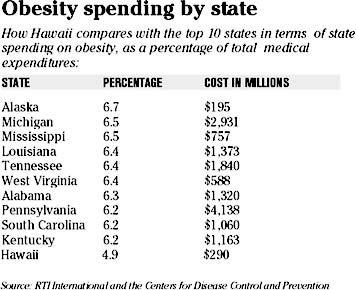
Obesity weighs heavy
on taxpayersA study shows Hawaii expends
$290 million a year on related costs
ATLANTA >> Taxpayers foot the doctor's bill for more than half of obesity-related medical costs, which reached a total of $75 billion in 2003, according to a new study.
The public pays about $39 billion a year -- or about $175 per person -- for obesity through Medicare and Medicaid programs, which cover sicknesses caused by obesity including type 2 diabetes, cardiovascular disease, several types of cancer and gallbladder disease.
The study, to be published tomorrow in the journal Obesity Research, evaluates state-by-state expenditures related to weight problems. The research was done by the nonprofit group RTI International and the Centers for Disease Control and Prevention.
"Obesity has become a crucial health problem for our nation, and these findings show that the medical costs alone reflect the significance of the challenge," said Tommy Thompson, secretary of the Department of Health and Human Services. "Of course, the ultimate cost to Americans is measured in chronic disease and early death."
States spend about one-twentieth of their medical costs on obesity -- from a low of 4 percent in Arizona to a high of 6.7 percent in Alaska.
The study found that Hawaii spends $290 million on obesity-connected health costs, 4.9 percent of total medical expenditures.
"I don't know the methodology of this study, but I don't think the conclusion is surprising," said Dr. Linda Rosen, of the state Department of Health. "It is a tremendous cost to society."
Rosen, deputy director for health resources administration, said it is difficult to put a price tag on what health officials recognize as "the obesity epidemic."
"One of the problems in trying to quantify the cost of obesity is that in and of itself, it is not coded disease -- not a billable diagnosis for an office visit -- so we are looking at health conditions where obesity is a risk factor. That includes diabetes, heart disease, several types of cancer, gallbladder disease."
"The dramatic decrease in physical activities fuels the obesity epidemic," said Rosen. "It's not that people don't exercise -- they don't move. There's the car, the channel changer, elevators, the sedentary workplace, kids getting driven everywhere.
"The answer is putting energy expenditure back in acts of daily living. We need to support environmental strategies -- not an exercise program, but ways that employers, schools, find for people to do work and move more."
Rosen said ways to fight obesity are being addressed by the Health Department's Healthy Hawaii Initiative, which is funded by money received from the tobacco industry settlement of a class-action suit about the effect on smoking on health care costs.
University of Hawaii research released in 2001 showed that Hawaii's youngsters are overweight at double the national rate. The five-year study to determine if Hawaii's children grow and develop normally found more than 20 percent of them are overweight.
The study by the University of Hawaii Kinesiology and Leisure Science Department in the College of Education and the Brigham Young University Exercise and Sport Science Department measured about 1,400 students, ages 6 to 17, in an unidentified community.
About 64 percent of adults in the United States are either overweight or obese, according to the CDC's 1999-2000 National Health and Nutrition Examination Survey.
The Associated Press and Star-Bulletin reporter Mary Adamski contributed to this report.
